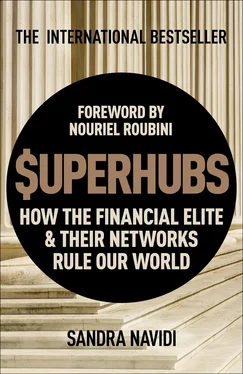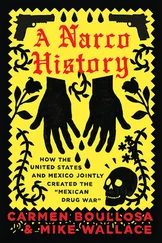Sandra Navidi - SuperHubs - How the Financial Elite and Their Networks Rule our World
Здесь есть возможность читать онлайн «Sandra Navidi - SuperHubs - How the Financial Elite and Their Networks Rule our World» весь текст электронной книги совершенно бесплатно (целиком полную версию без сокращений). В некоторых случаях можно слушать аудио, скачать через торрент в формате fb2 и присутствует краткое содержание. Год выпуска: 2017, Издательство: Hodder & Stoughton, Жанр: Старинная литература, на английском языке. Описание произведения, (предисловие) а так же отзывы посетителей доступны на портале библиотеки ЛибКат.
- Название:SuperHubs: How the Financial Elite and Their Networks Rule our World
- Автор:
- Издательство:Hodder & Stoughton
- Жанр:
- Год:2017
- ISBN:нет данных
- Рейтинг книги:4 / 5. Голосов: 1
-
Избранное:Добавить в избранное
- Отзывы:
-
Ваша оценка:
- 80
- 1
- 2
- 3
- 4
- 5
SuperHubs: How the Financial Elite and Their Networks Rule our World: краткое содержание, описание и аннотация
Предлагаем к чтению аннотацию, описание, краткое содержание или предисловие (зависит от того, что написал сам автор книги «SuperHubs: How the Financial Elite and Their Networks Rule our World»). Если вы не нашли необходимую информацию о книге — напишите в комментариях, мы постараемся отыскать её.
SuperHubs: How the Financial Elite and Their Networks Rule our World — читать онлайн бесплатно полную книгу (весь текст) целиком
Ниже представлен текст книги, разбитый по страницам. Система сохранения места последней прочитанной страницы, позволяет с удобством читать онлайн бесплатно книгу «SuperHubs: How the Financial Elite and Their Networks Rule our World», без необходимости каждый раз заново искать на чём Вы остановились. Поставьте закладку, и сможете в любой момент перейти на страницу, на которой закончили чтение.
Интервал:
Закладка:
* * *
We have seen that the networks of the financial elite are so tightly knit that people rarely fall through the cracks. By banding together and blocking reform, superhubs perpetuate the system to their benefit at the expense of everyone else. Based on network science, we will see in Chapter 12 how their collective actions have lead to a crisis of capitalism, revolt, and risk of system failure. We will examine how the system should be recalibrated in order to create a more inclusive society with a fairer economy that benefits all.
CHAPTER 12
Super-Crash:
“Executive Contagion”
THE CRASH OF A TITAN: JOHN MERIWETHER
Few people can take credit for generating billions of dollars in losses and single-handedly bringing01he0.inancial system to the brink of collapse. John Meriwether of Long Term Capital Management (LTCM) is one of them. At a wine tasting at Chef Daniel Boulud’s DBGB in the East Village, hosted by my friend Jim, a financier and avid wine collector, I met the now infamous Meriwether. I arrived later than most of the other guests, who had gathered in the center of the private wood-paneled room featuring an elegant table set with a myriad of different wine glasses, shiny silverware, and sharply folded napkins. In a tribute to Château Mouton Rothschild, the theme of the tasting was “Mouton Madness.” An array of bottles had been carefully lined up on a side table, and the menu was designed to enhanc the tasting experience.
As we mingled during the cocktail hour, I checked the place cards. To my delight, I saw that I would be seated by John Meriwether, the John Meriwether, who had made Wall Street history. In light of his colorful background, I expected a charismatic and swashbuckling personality who would mesmerize us with fascinating anecdotes; yet, contrary to my expectations, in walked a slight, unimposing, and shy man. He talked the entire evening about sports, despite my best efforts to move on to more compelling subjects. Intensely private, he was possibly trying to avoid talking about what everyone was most interested in: his notorious experience at LTCM.
As outlined in Roger Lowenstein’s book When the Genius Failed, Meriwether began his career at Salomon Brothers, where he had made a name for himself as the head of the enormously profitable bond arbitrage group.1 In the course of a trading scandal that implicated his subordinates, though not him, he resigned. Motivated by a desire to vindicate himself, he set out for bigger and better things and in 1994 created a hedge fund that invested on the basis of global economic trends. With his stellar reputation, two highly regarded Nobel laureates—Myron Scholes and Robert Merton—on his team, and wide-ranging contacts, he went on an aggressive global marketing tour, selling the fund as a low-risk market outperformer.
LTCM’s investments were based on complex computer formulae that hardly anyone fully understood but which Meriwether and his team believed to be infallible. Investors flocked to the fund, eager to join the ride and associate themselves with a circle of managers uniformly considered to be simply ingenious. For the privilege of investing, they were willing to accept high minimum investment thresholds, unusually long lockup periods, large management fees, and very little disclosure of where and how their money was actually invested. The more money LTCM received, the more it attracted, and in short order it accumulated $126 billion in assets. In 1995 and 1996, the fund generated in excess of 40 percent return after fees. Such outsized returns were only possible with extremely high leverage, which magnified the returns. However, when the tide turned, the debt also magnified the losses.
LTCM hedged itself within a known range of volatility based on past data, but its financial models failed to consider close correlations between a variety of asset classes. When in 1998 Russia defaulted and sent markets tumbling, the value of LTCM’s investments fell steeply. Within a couple of months, the fund lost over 50 percent of its value. Alarmed by its dramatic losses, the New York Fed intervened—although technically the fund was not within their purview—because many Wall Street counterparties, among them countless banks and investors such as pension funds, were intertwined with LTCM and in danger of failing. Consequently, the Fed feared that a disorderly unraveling of over $100 billion in derivative positions would cause the entire financial system to crash. William J. McDonough, the extraordinarily well-connected president of the New York Fed, had sufficient pull to congregate the superhubs of Wall Street, who within hours coughed up $3.6 billion for a 90 percent stake in the fund. Among the rescuers were government entities, such as the People’s Bank of China, and Wall Street icons George Soros and Donald Marron, chairman of Paine Webber.2
Following the implosion of LTCM, Meriwether subsequently launched two other funds, and, despite his prior spectacular failure, investors were still willing to entrust their money to him. The first successor fund faltered in the throes of the financial crisis and had to be wound down. The next fund he started, he eventually converted into a family office.
The LTCM debacle foreshadowed the financial crisis that would engulf the entire global financial system a decade later. Meriwether, a bona fide superhub, held so much network power over people and capital that he nearly toppled the entire financial system. Reassured by his then-stellar reputation, investors lined up to give him their money even under unfavorable conditions, submitting themselves to an unproven and opaque investment approach. Other financial institutions generously loaned him enormous amounts of capital based on his pedigree while lacking the information necessary to control their risk exposure—therefore increasing the risk for the system as a whole. In accordance with power-laws, once this superhub started spinning, he attracted everyone and everything in his path like a tornado set for destruction.
THE BIG PICTURE: CAPITALISM IN CRISIS
The global financial crisis has laid bare a capitalism gone awry with dramatic consequences for us all. What happened? When I visited the U.S. for the first time over three decades ago, I was struck by how prosperous it seemed compared to Europe. American middle-class families appeared to have much higher living standards than Germans, with huge houses, numerous cars in their driveways, and apparently unconstrained financial means. Later in my career in structured finance, where highly leveraged assets like homes and companies are securitized and sold all over the world, I came to wonder how all of this was sustainable. Today we know that the engine behind excessive consumption has been financialization fueled with debt.
Debt and Financialization
Debt has been one of the key drivers of inequality. According to a McKinsey study, “global debt has grown by $57 trillion . . . outpacing world GDP growth” and “no major economy has decreased its debt-to-GDP ratio since 2007.”3 In the decades preceding the crisis, an increasingly greater share of GDP had been based on financial services, which in turn had been based on credit growth. However, financialization only contributes to growth up to a certain point before this trend reverses.4 As finance takes up an increasingly larger share of GDP, investment in the real economy falls.5 The author and former banker Satyajit Das notes that “[at] its peak, the finance industry generated 40 percent of corporate profits.”6 As a result finance decoupled from the economy, and while Wall Street got richer, everyone else got poorer, thereby increasing the wealth gap. Financialization has also contributed significantly to corporate ownership and control, which has expanded and strengthened elite networks even further.
Читать дальшеИнтервал:
Закладка:
Похожие книги на «SuperHubs: How the Financial Elite and Their Networks Rule our World»
Представляем Вашему вниманию похожие книги на «SuperHubs: How the Financial Elite and Their Networks Rule our World» списком для выбора. Мы отобрали схожую по названию и смыслу литературу в надежде предоставить читателям больше вариантов отыскать новые, интересные, ещё непрочитанные произведения.
Обсуждение, отзывы о книге «SuperHubs: How the Financial Elite and Their Networks Rule our World» и просто собственные мнения читателей. Оставьте ваши комментарии, напишите, что Вы думаете о произведении, его смысле или главных героях. Укажите что конкретно понравилось, а что нет, и почему Вы так считаете.












